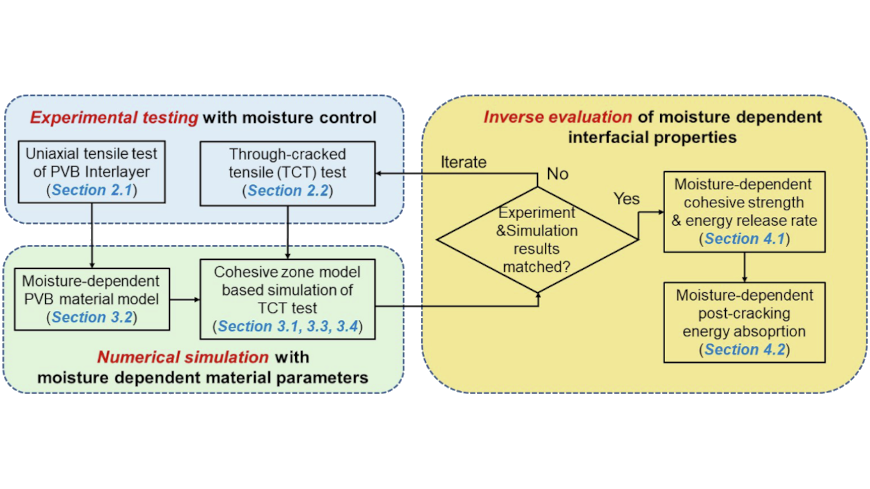Effect of moisture on the delamination properties of fractured PVB-laminated glass: A joint experimental and numerical study
New Publication in “Composite Structures”
2023/07/28

Authors: Xing Chen, Binbin Lin, Miriam Schuster, Suwen Chen, Bai-Xiang Xu and Jens Schneider
In practical applications of laminated glass, local moisture exchange may occur through panel edges or glass cracks and leads to a significant impact on the post-fracture behavior of laminated glass. In this paper, the effect of moisture on the interfacial delamination properties of PVB-laminated glass is studied. At the experimental level, quasi-static uniaxial tensile tests on pure PVB and through-cracked tensile tests on PVB-laminated glass were conducted at room temperature, considering four initial moisture levels, i.e., 0.2%, 0.4%, 0.6%, and 0.8%, corresponding to relative humidity of 13.6%, 25.6%, 36.1%, and 44.5%, respectively. It is worth noting that for each laminated glass specimen used in the TCT tests, a controlled moisture content was uniformly introduced into the interlayer during the manufacturing process, which is different from traditional aging tests. This allowed for characterization of the moisture-dependent material properties of PVB and interfacial delamination properties of fractured PVB-laminated glass under controlled and uniform moisture conditions. At the numerical level, the moisture-dependent material behavior of the PVB interlayer was first calibrated with 5-parameter Mooney-Rivlin hyperelastic material laws. The moisture-dependent material laws and through-cracked tensile (TCT) test results were then used for an inverse determination of the cohesive strength and interfacial fracture energy at PVB-glass interface through a numerical cohesive zone approach. This study found that the moisture content can significantly affect the interfacial properties of the PVB-laminated glass, with the cohesive strength and interfacial fracture energy decreasing by approximately 70% and 50%, respectively, as the moisture content increases from 0.2% to 0.8%. The changes of the above interfacial parameters can be approximated by linear relationships. In addition, the energy absorption of fractured PVB laminated glass decreases significantly with increasing moisture content due to the degradation of PVB interlayer performance and reduced interfacial adhesion. Therefore, the effect of moisture content should be considered in the practical design of certain laminated glass applications to ensure post-fracture load-bearing capacity.
Link to Article
Composite Structures, vol. 322, p. 117381 Okt. 2023



